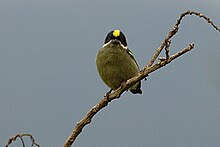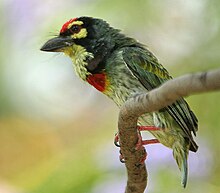Bearded birds
The division of living beings into systematics is a continuous subject of research. Different systematic classifications exist side by side and one after the other. The taxon treated here has become obsolete due to new research or is not part of the group systematics presented in the German-language Wikipedia.

The bearded birds are a group of animals originally considered to be the woodpecker family with 82 species in 13 genera . The origin of the name lies in the stiff bristles emerging from the base of the beak.
The family described by Charles Lucien Bonaparte in 1838 is now considered a paraphyletic taxon, as they would only form a monophylum if the toucans (Ramphastidae) were included . They were therefore divided into four families, the African bearded birds (Lybiidae), the American bearded birds (Capitonidae), the Asian bearded birds (Megalaimidae) and the toucan bearded birds (Semnornithidae).
features
Bearded birds are 9 (African dwarf bearded birds) to 32 centimeters (green bearded birds) long. Most species do not exhibit sexual dimorphism. Many species have colorful plumage. Bearded birds have an arsenal of very loud calls. Usually they consist of a phrase that is repeated many times.
Way of life
Bearded birds usually stay in the foliage of the trees; despite their colorful plumage, they are well camouflaged there. Bearded birds feed on insects and fruits.
Bearded birds are usually only found in high-yield sources of food such as large, fruit-bearing trees in large quantities, otherwise they live solitary or in pairs.
Some species of bearded birds breed only in a very limited season, others throughout the year. Like all woodpecker birds, bearded birds are cave-breeders. The caves, chopped into rotten wood with the powerful beak, are characterized by a long passage into a large nesting chamber. These caves are often used as a sleeping place outside of the breeding season. Occasionally bearded birds occupy the old burrows of other woodpecker birds. The females lay about two to five white eggs with longitudinal grooves in the brood cavity, which is padded with sludge or wood chips. The eggs are incubated alternately by both parents, but the male only breeds in exceptional cases at night. The chicks, which are naked and blind when they hatch, have strong callouses on their heels. After four to five weeks, they leave the brood cavity with a much less colorful plumage, which later turns color.
Systematics
African bearded birds
The African bearded birds (Lybiidae) live with 42 species in the forests and savannas of Africa. The birds are nine to 24 centimeters long. Their plumage is usually brownish or olive in color. The vertex black or brown with contrasting yellow, red, black or white spots. African bearded birds are monogamous. They lay two to six eggs. Both parents take part in the rearing of the young, often supported by young birds from previous broods.



- Genus: Buccanodon
- Yellow-spotted bearded bird ( Buccanodon duchaillui )
- Genus: Bearded Mustache ( Gymnobucco )
- Black Bearded Bird ( Gymnobucco bonapartei )
- Bald Beard Bird ( Gymnobucco calvus )
- Borstenbartvogel , Pelbartvogel ( Gymnobucco peli )
- Sootbeard bird ( Gymnobucco sladeni )
- Genus: Toothbeard birds ( Lybius )
- Double-toothed bearded bird ( Lybius bidentatus )
- Fig bearded bird ( Lybius chaplini )
- Senegal Furchenschnabel , Furchenschnabelvogel ( Lybius dubius )
- Purple mask bearded bird ( Lybius guifsobalito )
- Bald Bearded Bird ( Lybius leucocephalus )
- Brown-breasted bearded bird ( Lybius melanopterus )
- Rose-bellied bearded bird ( Lybius minor )
- Black-breasted fur -beak ( Lybius rolleti )
- Red-faced bearded bird ( Lybius rubrifacies )
- Collared bearded bird or black-necked bearded bird ( Lybius torquatus )
- Bartvogel shaft ( Lybius undatus )
- Blood-breasted bearded bird ( Lybius vieilloti )
- Genus: dwarf bearded birds or dwarf beards ( Pogoniulus )
- Red- rump bearded bird ( Pogoniulus atroflavus )
- Yellow-tufted dwarf bearded or banded dwarf bearded ( Pogoniulus bilineatus )
- Yellow-fronted bearded bird or yellow-fronted dwarf bearded ( Pogoniulus chrysoconus )
- Yellow-bridged bearded bird ( Pogoniulus coryphaeus )
- Mountain bearded bird ( Pogoniulus leucomystax )
- Makawa bearded bird ( Pogoniulus makawai )
- Fire-browed bearded bird ( Pogoniulus pusillus )
- Spotted dwarf mustard or shed dwarf mustard ( Pogoniulus scolopaceus )
- Plain bearded bird ( Pogoniulus simplex )
- Yellow-throated dwarf bearded ( Pogoniulus subsulphureus )
- Genus: Stactolaema
- Straw-headed bearded bird ( Stactolaema anchietae )
- White-eared bearded bird ( Stactolaema leucotis )
- Olive whisker ( Stactolaema olivacea )
- Mirror bearded bird ( Stactolaema whytii )
- Genus: Bearded Birds ( Trachyphonus )
- Latticed bearded bird ( Trachyphonus darnaudii )
- Flamehead bearded bird ( Trachyphonus erythrocephalus )
- Perlbartvogel ( Trachyphonus margaritatus )
- Yellow-billed bearded bird ( Trachyphonus purpuratus )
- Crested bearded bird or black-backed bearded bird ( Trachyphonus vaillantii )
- Genus: Bearded mustache ( Tricholaema )
- Diadem hair beard ( Tricholaema diademata )
- Miombo bearded bird ( Tricholaema frontata )
- Spotted bearded bird ( Tricholaema hirsuta )
- Diadem Bearded Bird ( Tricholaema lacrymosa )
- Red-fronted bearded bird ( Tricholaema leucomelas )
- Black-headed bearded bird ( Tricholaema melanocephala )
American bearded birds
The American bearded birds (Capitonidae) live with 14 species in the forests of Central and South America . The birds become 15 to 20 centimeters long. Their plumage is often very brightly colored. Their head is large, their beak large and heavy, often with tooth-like recesses on the edges of the beak. The wings are rounded, the legs short and strong. They feed on fruits, insects and plunder the nests of smaller birds. American bearded birds are monogamous . They lay two to five eggs. Both parents take part in the rearing of the young, often supported by young birds from previous broods.

- Genus: Bearded Beards ( Capito )
- Capito auratus
- Olive-backed bearded bird or black bearded bird ( Capito aurovirens )
- Cinnamon Breast Bearded Bird ( Capito brunneipectus )
- Throat banded bearded bird ( Capito dayi )
- Capito fitzpatricki
- White-mantled bearded bird ( Capito hypoleucus )
- Teardrop-whiskered bird ( Capito maculicoronatus )
- Polka dot beard bird ( Capito niger )
- Five-colored bearded bird ( Capito quinticolor )
- White-naped bearded bird ( Capito squamatus )
- Loreto bearded bird ( Capito wallacei )
- Genus: Dwarf mustaches ( Eubucco )
- Andean bearded bird or redhead bearded bird ( Eubucco bourcierii )
- Golden breasted bearded bird ( Eubucco richardsoni )
- Scarlet Bearded Bird ( Eubucco tucinkae )
- Great Bearded Bird ( Eubucco versicolor )
Toucan bearded birds
The bearded birds of the genus Semnornis are more closely related to the toucans (Ramphastidae) than to the genera of the American bearded birds. They are therefore placed in a separate family in recent publications, the toucan bearded birds (Semnornithidae).
- Genus: Prickly Beak ( Semnornis )
- Aztec Bearded Bird , Aztec Knackbärtling or Zinc Beak ( Semnornis frantzii )
- Toucan bearded bird ( Semnornis ramphastinus )
Asian bearded birds
The Asiatic bearded birds (Megalaimidae) live with 26 species in the forests of Asia. The birds become 15 to 33 centimeters long. Their plumage is green, in one species brownish, and has contrasting, colored spots on the head and chest. They feed on fruits, insects and plunder the nests of smaller birds. Asian bearded birds are monogamous . They lay two to four eggs. Both parents take part in the rearing of the young, often supported by young birds from previous broods.


- Genus: Calorhamphus
- Malay Bearded Bird ( Calorhamphus hayii )
- Borneo brown beard bird ( Calorhamphus fuliginosus )
- Genus: Psilopogon
- Red Tufted Bearded Bird or White Bearded Bird ( Psilopogon pyrolophus )
- Genus: Green Bearded Birds ( Megalaima )
- Megalaima armillaris
- Blue-cheeked bearded bird ( Megalaima asiatica )
- Megalaima australis
- Megalaima chrysopogon
- Megalaima corvina
- Megalaima eximia
- Megalaima faiostricta
- Golden-browed bearded bird ( Megalaima flavifrons )
- Golden-throated bearded bird ( Megalaima franklinii )
- Gold Bartvogel ( Megalaima haemacephala )
- Megalaima henricii
- Green-sided bearded bird ( Megalaima incognita )
- Java bearded bird ( Megalaima javensis )
- Megalaima lagrandieri
- Striped bearded bird ( Megalaima lineata )
- Megalaima malabarica
- Megalaima monticola
- Red-headed bearded bird ( Megalaima mystacophanos )
- Megalaima oorti
- Megalaima pulcherrima
- Megalaima rafflesii
- Megalaima rubricapilla
- Howlbeard bird or bluehead bearded bird ( Megalaima virens )
- Green bearded bird ( Megalaima viridis )
- Ceylon Green Bearded Bird ( Megalaima zeylanica )
literature
- H. Schifter: Bartvögel family . In: Bernhard Grzimek (ed.): Grzimeks Tierleben Vögel 3 , Bechtermünz Verlag, Augsburg 2000 (unchanged reprint of the 1970/80 edition), ISBN 3-8289-1603-1
Web links
Individual evidence
- ^ Cornell University, Department of Ecology and Evolutionary Biology African barbets
- ↑ Harshman, John. 2008. African barbets. Version 27 June 2008 (under construction). in The Tree of Life Web Project
- ^ Cornell University, Department of Ecology and Evolutionary Biology New World barbets
- ↑ Glenn F. Seeholzer, Benjamin M. Winger, Michael G. Harvey, Daniel Cáceres & Jason D. Weckstein. A new species of barbet (Capitonidae: Capito) from the Cerros del Sira, Ucayali, Peru. The Auk , 2012 doi : 10.1525 / auk.2012.11250
- ^ A b Tree of Life Web Project. 2008. New World barbets. Version 27 June 2008 (under construction). in The Tree of Life Web Project
- ↑ WorldBirdNames.org ( Memento of May 13, 2007 in the Internet Archive )
- ↑ birdstack Genera in the family Semnornithidae (Prong-billed and Toucan Barbets) ( Memento of the original from January 2, 2011 in the Internet Archive ) Info: The archive link was inserted automatically and has not yet been checked. Please check the original and archive link according to the instructions and then remove this notice.
- ^ Cornell University, Department of Ecology and Evolutionary Biology Asian barbets
- ↑ Harshman, John. 2008. Asian barbets. Version 27 June 2008 (under construction). in The Tree of Life Web Project



